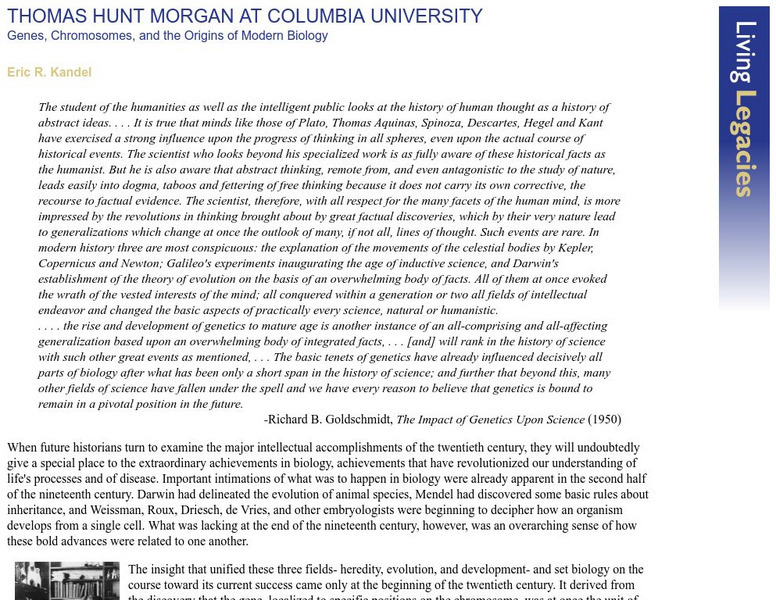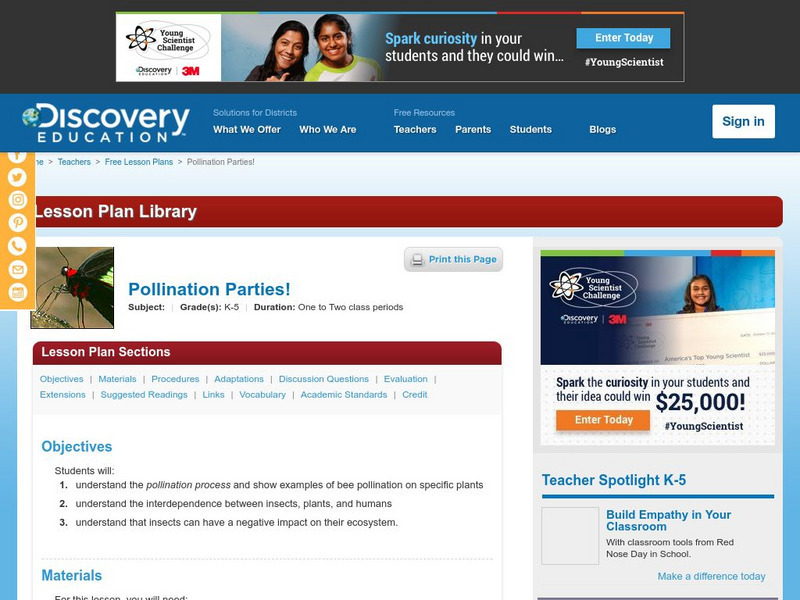BBC
Bbc: Gcse Bitesize: Biology (Combined Science)
This site provides a list of topics and links to the Biology Combined Science courses and the contents of each course.
Columbia University
Columbia University: Thomas Hunt Morgan
The site promotes the importance of Morgan and his experiments in genetics with fruit flies on the field of biology.
Purdue University
Purdue University: A Basic Overview of Aquaculture [Pdf]
A vocational discussion of aquaculture that includes a history of the field, its environmental impact, use of water, and the like. (Published in 1900.)
BiologyWise
Biology Wise: Glossary of Biology Terms and Definitions
Gives the dictionary definitions for a lengthy list of biology and microbiology terms.
Other
Digital Library for Earth System Education (Dlese)
This resource provides materials for teachers on a huge array of topics. Search site by topic, grade level, and desired output (such as lesson plan, case study, assessment or tutorial). Site is focused on earth science, geography, and...
Discovery Education
Discovery Education: Pollination Parties
This activity helps students understand the concept of pollination. Objectives, materials, procedures, adaptations, discussion questions, evaluation, extensions, suggested readings, links, vocabulary, and academic standards are all...
PBS
Pbs Learning Media: Monarch Migration
This video from Nature features the start of the monarch butterfly's northward trek. [3:02]
PBS
Pbs Learning Media: Sharks in Our Future
In this video segment from Nature, see the value that sharks can have on the tourism industry in an area. [1:41]
Science Buddies
Science Buddies: Now You See It, Now You Don't! Test Your Peripheral Vision
The survival of our ancient ancestors depended on their ability to use peripheral vision to find prey and to avoid predators. Almost everything we do-from riding a bike, to dribbling a basketball, to reading a book-depends on peripheral...
PBS
Pbs Learning Media: A Cow's Digestive System
Learn how a cow eats and digests food in this video segment from Nature.
PBS
Pbs: Plum Landing
Invite students to visit ecosystems around the world with this collection. This collection includes activities for the classroom, after school, and families. Also included is games.
San Diego Zoo Global
San Diego Zoo: Kids: Ring Tailed Lemur
This San Diego Zoo resources gives the reader facts about the Ring-Tailed Lemur. Characteristics like diet, habitat and genetic makeup are shared.
San Diego Zoo Global
San Diego Zoo: Kids: Virginia Opossum
This San Diego Zoo resources gives the reader facts about the Virginia Opossum. Characteristics like diet, habitat and genetic makeup are shared.
San Diego Zoo Global
San Diego Zoo: Kids: Snow Leopard
This San Diego Zoo resources gives the reader facts about the Snow Leopard. Characteristics like diet, habitat and genetic makeup are shared.
San Diego Zoo Global
San Diego Zoo: Kids: Giraffe
This San Diego Zoo resource is a webpage that gives insight to the characteristics of the giraffe. Characteristics like diet, habitat and genetic makeup.
San Diego Zoo Global
San Diego Zoo: Kids: Great Horned Owl
This San Diego Zoo reference is a about the Great Horned Owl. The student will learn about the characteristics of this bird of prey like its diet, habitat and genetic makeup.
San Diego Zoo Global
San Diego Zoo: Kids: Blue Tongued Skink
Have you ever stuck your tongue out at someone? For people, it is considered bad manners, but for this lizard, it is a way to scare off a predator!
San Diego Zoo Global
San Diego Zoo: Kids: Bee
Bees fly from flower to flower, sipping nectar and collecting grains of pollen. Bees have a special tongue that sucks up the nectar and a crop in their throat for storing it until they get back to the hive, where it is turned into honey...
San Diego Zoo Global
San Diego Zoo: Kids: Bonobo
This San Diego Zoo resource gives insight to the Bonobo species. This resource gives insight on the diet, habitat and size of these animals.
San Diego Zoo Global
San Diego Zoo: Flowers
Certain plants are known for their eye-catching blooms. Think of roses, orchids, carnations, and tulips. We often refer to these plants as "flowers." A flower, though, is just one part and quite an important part of a plant. Not all...
San Diego Zoo Global
San Diego Zoo: Kids: Babirusa
This San Diego Zoo resource is a webpage about the Babirusa. Students will learn about characteristics such as the diet, habitat and size of this animal.
San Diego Zoo Global
San Diego Zoo: Kids: Arabian Oryx
This San Diego Zoo resource gives insight about the Arabian Oryz. Characteristics like diet, habitat and size.
San Diego Zoo Global
San Diego Zoo: Kids: Gecko
This San Diego Zoo resources gives the reader facts about the Gecko. Characteristics like diet, habitat and genetic makeup are shared.
San Diego Zoo Global
San Diego Zoo: Kids: Flamingos
This San Diego Zoo resources gives the reader facts about the Flamingos. Characteristics like diet, habitat and genetic makeup are shared.




![Purdue University: A Basic Overview of Aquaculture [Pdf] Primary Purdue University: A Basic Overview of Aquaculture [Pdf] Primary](https://d15y2dacu3jp90.cloudfront.net/images/attachment_defaults/resource/large/FPO-knovation.png)


